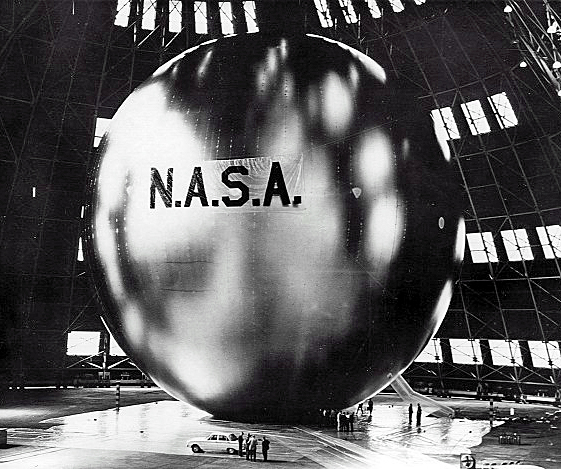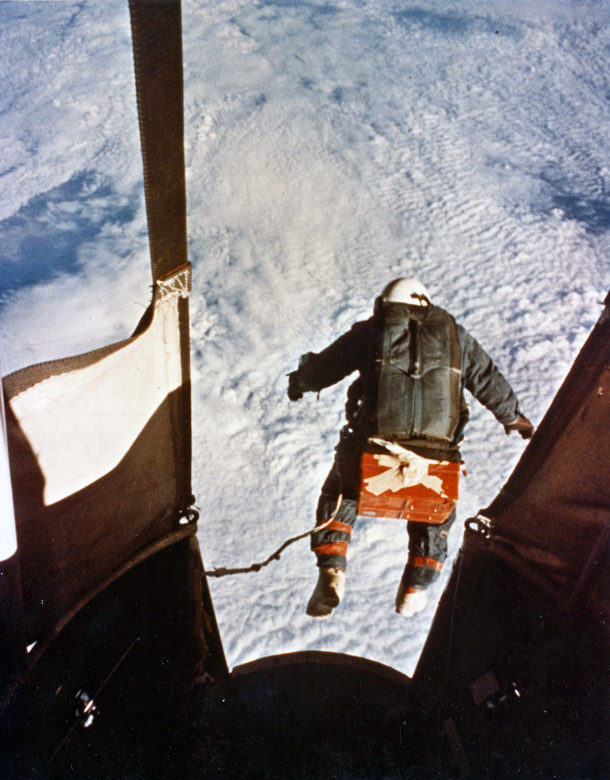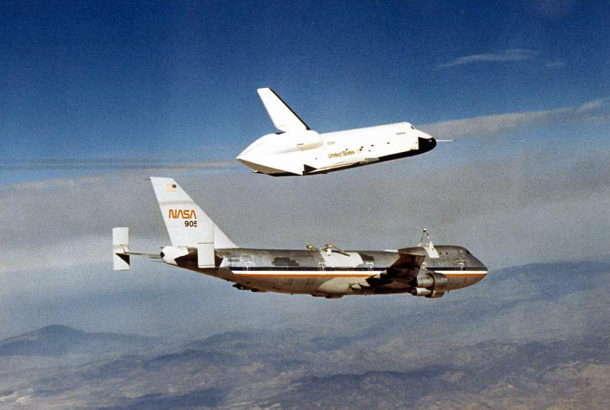
Sixty years ago this month, the United States successfully launched the Echo 1A passive communications satellite into Earth orbit. The 100-foot diameter balloon was among the largest objects ever to orbit the Earth.
A plethora of earth-orbiting communication satellites provide for a global connectivity that is commonplace today. Such was not always the case. Roll the clock back more than a half-century and we find that a global communications satellite system was just a concept. However, keen minds would soon go to work and provide mankind with yet another tangible space age benefit.
Communications satellites are basically of two types; passive and active. A passive communications satellite (PCS) simply reflects signals sent to it from a point on Earth to other points on the globe. An active communications satellite (ACS) can receive, store, modify and/or transmit Earth-based signals.
The earliest idea for a PCS involved the use of an orbiting spherical balloon. The balloon was fabricated from Mylar polyester having a thickness of a mere 0.5 mil. The uninflated balloon was packed tightly into a small volume and inserted into a payload canister preparatory to launch. Once in orbit, the balloon was released and then inflated to a diameter of 100 feet.
The system described above materialized in the late 1950′s as Project Echo. The Project Echo satellite was essentially a huge spherical reflector for transcontinental and intercontinental telephone, radio and television signals. The satellite was configured with several transmitters for tracking and telemetry purposes. Power was provided by an array of nickel-cadmium batteries that were charged via solar cells.
Echo 1 was launched from Cape Canaveral, Florida on Friday, 13 May 1960. However, the launch vehicle failed and Echo 1 never achieved orbit. Echo 1A (sometimes referred to as Echo 1) lifted-off from Cape Canaveral’s LC-17A at 0939 UTC on Friday, 12 August 1960. The Thor Delta launch vehicle successfully placed the 166-lb satellite into a 820-nm x 911-nm orbit.
An interesting characteristic of the Echo satellite was the large oscillation in the perigee of its orbit (485 nm to 811 nm) over several months. This was caused by the influences of solar radiation and variations in atmospheric density. While these factors are just part of the earth-orbital environment, their effects were much more noticeable for Echo due to the type’s large surface area-to-weight ratio.
Echo 1A orbited the Earth until it reentered the Earth’s atmosphere on Saturday, 25 May 1968. Echo 2 was a larger and improved version of Echo 1A. It measured 135-feet in diameter and weighed 547-lb. Echo 2 orbited the Earth between January of 1964 and June of 1969. Other than the Moon, both satellites were the brightest objects observable in the night sky due to their high reflectivity.
The Echo satellites served their function admirably. For a time, they were quite a novelty. However, progress on the ACS scene quickly relegated the PCS to obsolescence. Today, virtually all communication satellites are of the ACS variety.

Sixty years ago this week, USAF Captain Joseph W. Kittinger, Jr. successfully completed a daring parachute jump from 102,800 feet (19.5 miles). The historic bailout took place over the Tularosa Basin of New Mexico.
Kittinger’s jump was the final mission of the three-jump Project Excelsior flight research effort which focused on manned testing of the Beaupre Multi-Stage Parachute Parachute (BMSP). The system was being developed to provide USAF pilots with a means of survival from an extreme altitude ejection.
Transport to jump altitude was via a 3-million cubic foot helium balloon. Kittinger rode in an open gondola. He was protected from the harsh environment by an MC-3 partial pressure suit as well as an assortment of heavy cold-weather clothing. Kittinger and his jump wardrobe and flight gear weighed a total of 313 pounds
The Excelsior III mission was launched just north of Alamogordo, New Mexico at 11:29 UTC on Tuesday, 16 August 1960. Ninety-three minutes later, Kittinger’s fragile balloon reached float altitude. At 13:12 UTC, Kittinger stepped out of the gondola and into space. As he did so, he said: “Lord, take care of me now!”
The historic record shows that Joe Kittinger experienced a free-fall that lasted 4 minutes and 36 seconds. During this time, he fell 85,300 feet (16.2 miles). Incredibly, Kittinger reached a maximum free-fall velocity of 614 miles per hour (Mach 0.92) passing through 90,000 feet.
The BMSP worked as advertised. Kittinger entered the cloud deck obscuring his Tularosa Basin landing point at 21,000 feet. Main parachute deployment occurred at 17,500 feet. Total elapsed time from bailout to touchdown was 13 minutes and 45 seconds.
While Joe Kittinger and the Excelsior team focused on flight testing technology critical to the survival of fellow aviators, a byproduct of their efforts were aviation records that stood for over 50 years. Those achievements include: highest parachute jump (102,800 feet), longest free-fall duration (4 minutes 36 seconds – this record still stands), and longest free-fall distance (85,300 feet).

Fifty-six years ago this month, the fabled North American X-15 hit a speed of 3,590 mph (Mach 5.23) in a flight that reached an altitude of 103,300 feet. While decelerating through Mach 4.2, the nose gear of the aircraft unexpectedly deployed in flight.
The 114th powered flight of the legendary X-15 Program took place on Friday, 14 August 1964. USAF Major Robert A. Rushworth was at the controls of X-15 Ship No. 2 (S/N 56-6671). The mission would be Rushworth’s 22nd flight in the famed hypersonic aircraft.
X-15 drop from the NB-52A (S/N 52-0003) launch aircraft took place over Delamar Dry Lake, Nevada. Seconds later, Rushworth called for 100% power from the X-15’s XLR-99 liquid-fueled rocket engine as he pulled into a steep climb. He subsequently pushed-over and then leveled-off at 103,300 feet.
XLR-99 burnout occurred 80.3 seconds after ignition. At this juncture, the X-15 was traveling at 3,590 mph; better than 5 times the speed of sound. Following rocket motor burnout, the aircraft slowed and began to lose altitude under the influence of weight and aerodynamic drag.
As the Mach meter needle passed through Mach 4.2, Rushworth heard a loud bang from the airframe. The aircraft became hard to control as it gyrated in pitch, yaw and roll. Rushworth was equal to the moment and brought his troubled steed under control. However, the aircraft had an uncommanded sideslip and Rushworth had to use left aileron to hold the wings level.
Gathering his wits, Rushworth realized that the loud bang he heard was very similar to that which occurred when the nose gear was deployed in the landing pattern. Unaccountably, the X-15 nose gear had deployed in supersonic flight. An unsettling confirmation of Rushworth’s hypothesis came when the pilot spotted smoke, quite a bit of it, in the X-15 cockpit.
As Rushworth neared Edwards Air Force Base, chase aircraft caught up with him and confirmed that the nose gear was indeed down and locked. Further, the tires were so scorched from aerodynamic heating that they probably would disintegrate during touchdown on Rogers Dry Lake. They verily did.
Despite his tireless nose gear, Rushworth was able to control the rollout of his aircraft fairly well on the playa silt. He brought the X-15 to a stop and deplaned. Man and machine had survived to fly another day.
Post-flight analysis revealed that expansion of the X-15 fuselage due to aerodynamic heating was greater than expected. The nose gear door bowed or deformed outward more than anticipated as well. Together, these two anomalies caused the gear uplock hook to bend and release the nose gear. Fixes were subsequently made to Ship No. 2 to prevent a recurrence of the nose gear door deployment anomaly.
Rushworth next flew X-15 Ship No. 2 on Tuesday, 29 September 1964. He reached a maximum speed of 3,542 mph (Mach 5.2) at 97,800 feet. The nose gear door remained locked. However, while decelerating through Mach 4.5, Rushworth heard a bang that was less intense than the previous flight. This time, thermal stresses caused the nose gear door air scoop to deploy in flight. While the aircraft handled poorly, Rushworth managed to get it and himself back on the ground in one piece.
Following another redesign effort, Rushworth took to the air in X-15 Ship No. 2 on Thursday, 17 February 1965. He hit 3,539 mph (Mach 5.27) at 95,100 feet. On this occasion, both the nose gear door and nose gear door scoop remained in place. Unfortunately, the right main landing skid deployed at Mach 4.3 and 85,000 feet.
Thermal stresses were once again the culprit. Despite degraded handling qualities with the landing skid deployed, the valiant Rushworth safely landed the X-15. Upon deplaning, he is reported to have kicked the aircraft in a show of disgust and frustration. Unprofessional maybe, but certainly understandable.
Yet another redesign effort followed in the aftermath of the unexpected main landing skid deployment. This was the third consecutive mission for X-15 Ship No. 2 and Rushworth to experience a thermally-induced landing gear or landing skid deployment anomaly. Happily, subsequent flights of the subject aircraft were free of such vexing problems.

Forty-three years ago this month, the Space Shuttle Orbiter Enterprise successfully completed the first free flight of the Approach and Landing Tests (ALT) Program. NASA Astronauts Fred W. Haise, Jr. and Charles G. “Gordon” Fullerton were at the controls of the pathfinder orbiter vehicle (OV-101).
Developers of the Space Shuttle Orbiter faced the challenge of designing a vehicle capable of flight from 17,500 mph (Mach 28) at entry interface (400,000 ft) to 220 mph (Mach 0.3) at landing. Complicating this task was the fact that the Orbiter flew an unpowered, lifting entry that covered a distance of more than 4,400 nm. Once at the landing site, Shuttle pilots had a single opportunity to land the winged ship.
An Orbiter’s approach to the landing field is quite steep compared to that of a commercial airliner. Whereas the glide slope of the latter is around 2-3 degrees, the Orbiter’s flight path during approach is about 22 degrees below the horizon. Falling like a rock is an apt description of its flight state.
The Space Shuttle Approach and Landing Tests (ALT) involved a series of flight tests intended to verify the subsonic airworthiness and handling qualities of the Orbiter. Conducted at Edwards Air Force Base between February and October 1977, the ALT employed a modified Boeing 747 known as the Shuttle Carrier Aircraft (SCA). The Orbiter Enterprise was attached atop the SCA to hitch a ride to altitude.
The Shuttle ALT consisted of a total of thirteen (13) flight tests; five (5) Captive-Inactive (CI) tests, five (5) Captive-Active (CA) tests and three (3) Free Flight (FF) tests. CI testing was aimed at verifying the handling qualities of the SCA-Orbiter combination in flight. There was no crew was onboard the Orbiter for these tests. CA testing focused on preparing for the upcoming free flight series. A crew flew onboard the Orbiter which remained mated to the SCA.
The ALT Free Flights were where the rubber met the road so to speak. The Enterprise and her crew separated from the SCA at altitudes ranging from between 19,000 and 26,000 ft to test the Orbiter in free flight. Landings were made initially on Rogers Dry Lake (Runway 17) and ultimately on Edwards’ 15,000-ft concrete runway (Runway 22).
The Enterprise was flown in two (2) different configurations. The first involved the use of a tailcone fairing which streamlined the base region of the Orbiter. This increased the Orbiter’s lift-to-drag ratio which decreased the vehicle’s rate of descent. It also reduced the level of buffeting experienced by the SCA’s empennage while the Orbiter rode atop the carrier aircraft.
The second Enterprise configuration flown involved removal of the tailcone. This significantly reduced the Orbiter’s lift-to-drag ratio and correspondingly increased the rate of sink. Indeed, the Orbiter’s descent rate without the tailcone was roughly twice as high as that with the tailcone. Removal of the tailcone also markedly increased the buffet loads sustained by the SCA’s empennage.
ALT Free Flight No. 1 took place on Friday, 12 August 1977. With Fitzhugh L. Fulton, Jr. and Thomas C. McMurtry flying the SCA (N905NA), the Enterprise and her crew of Haise and Fullerton was carried to an altitude of 24,100 ft. At a speed of 310 mph in a slight dive, the big glider cleanly separated from the SCA. Just 321 seconds later, the Orbiter touched-down on Rogers Dry Lake at 213 mph.
ALT Free Flights No. 2-5 were successfully conducted over the next several months. Astronauts Joseph H. Engle and Richard H. Truly flew Enterprise on the second and fourth free flights while Haise and Fullerton manned the Orbiter’s cockpit on the third and fifth missions.
Enterprise flew without the tailcone during the last two ALT flights. As expected, the trip downstairs was rapid. Time of descent from 22,400 ft for Free Flight No. 4 was 154 seconds with a landing speed of 230 mph. Free Flight No. 5 took only 121 seconds to descend 19,000 ft and landed at 219 mph.
ALT Free Flight No. 5 was notable in that (1) the Enterprise made its first landing on concrete and (2) a Pilot-Induced Oscillation (PIO) occurred at initial touchdown. For a few tense moments Command Pilot Haise struggled to keep his skittish steed on the ground. Following several disturbing skips and bounces, the Enterprise finally settled down and rolled to a stop.
The Space Shuttle Approach and Landing Tests (ALT) were a necessary prelude to space for the Orbiter. Indeed, the ALT flights represent the first time that NASA’s new winged reentry vehicle took to the air. Having successfully demonstrated the ability to safely land an Orbiter, the next flight in the Space Shuttle Program would be STS-1 in April 1981. Interestingly, that 2-day mission would come to a successful conclusion when the Columbia landed on Rogers Dry Lake back at Edwards Air Force Base, California.





